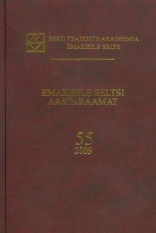TULE TAEVAS APPI, TULGE OMETI RAEKOJA PLATSIST KAUGEMALE KA: KODANIKE TEKSTISTRATEEGILISED VALIKUD AMETIASUTUSE POOLE PÖÖRDUMISEL
GOOD HEAVENS, WHY WON’T YOU LOOK A BIT FURTHER FROM THE TOWN HALL SQUARE!: THE STRATEGIC CHOICES USED BY CITIZENS IN TEXTS WRITTEN TO AUTHORITIES
Author(s): Riina ReinsaluSubject(s): Communication studies, Finno-Ugrian studies, ICT Information and Communications Technologies
Published by: Teaduste Akadeemia Kirjastus
Keywords: complaint; institutional communication; text type; metadiscourse; genre analysis; Estonian;
Summary/Abstract: One of the preconditions of a well-functioning information society is dialogic communication between citizens and officials. For this, agencies provide several options, including the chance to indicate problems via a web form. The objective of the article is to clarify which are the strategic text choices of citizens when they contact officials with a complaint. In other words, the article focuses on which obligatory and selective moves comprise the internal structure of the complaints of the survey subjects and which metadiscursive linguistic devices are used for conveying the content. The source material of the article is 40 complaints (2659 words in total) submitted by citizen to the Tartu city government from 2013–2017. The complaints are taken from the public webpage section “Official answers” and concern the city’s maintenance issues. Dealing with maintenance issues brings an intrigue into the communication, as the authorities are considered to be directly or indirectly liable for the problem. However, as it is in the power of the authorities to remedy the situation, it may be presumed that a citizen must be careful when making strategic choices in texts, carefully selecting the way of addressing the authorities. Applying the genre analysis of Swales (1990) when analysing the source material, it appears that the internal structure of the complaint consists of three compulsory moves – pointing out the problem, expressing discontent and naming the recommended activity – which are closely intertwined. Selective moves, dealing with starting and ending the communication, introducing the background and describing the situation, are secondary compared to the general objective of the complaint. Internal structure moves in texts are realised as multiple metatextual features, of which Hyland’s (2005b) linguistic devices included in the interaction features in the framework of metadiscourse are of interest in the context of this article. Although from time to time citizens consider it necessary to mitigate their text with hedges, a negative perception still dominates in the complaints, conveyed through attitude markers and boosters. Discontent is expressed not only in words, but also through emotions. The punctuation marks that carry an emotional charge are exclamation marks as well as question marks, which are traditionally considered engagement markers, and in some cases these also meet the same objective. In the latter case, the citizen is primarily speaking for himself/herself, not for a group, using the first person, which represents the category of self-mentions.
Journal: Emakeele Seltsi aastaraamat
- Issue Year: 2017
- Issue No: 63
- Page Range: 201-220
- Page Count: 20
- Language: Estonian

